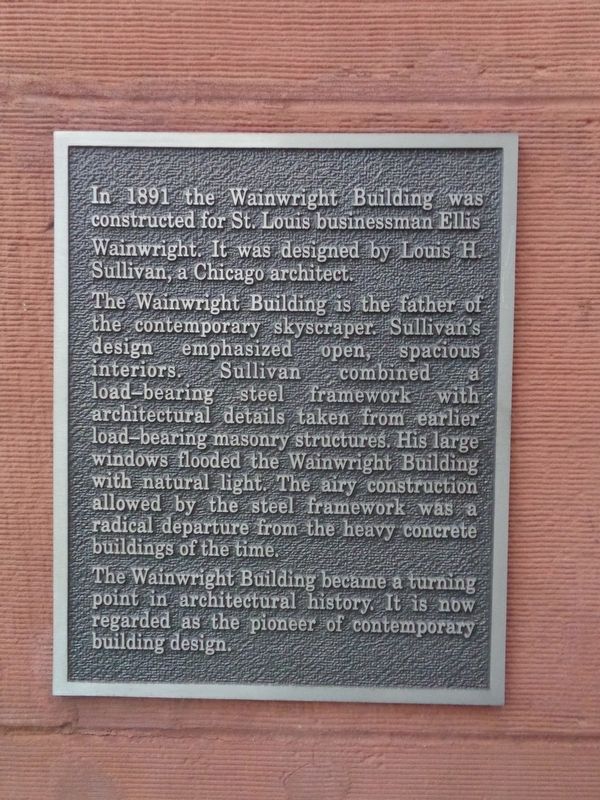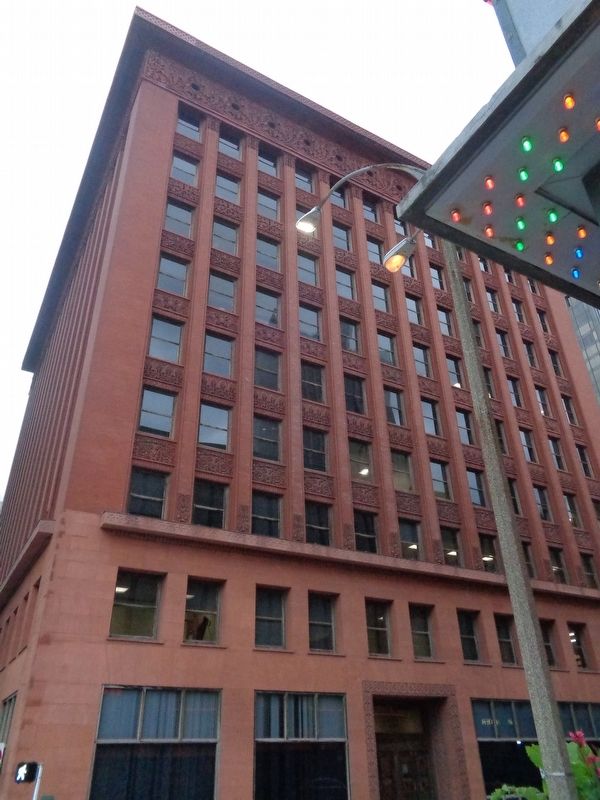Downtown in St. Louis, Missouri — The American Midwest (Upper Plains)
Wainwright Building
The Wainwright Building is the father of the contemporary skyscraper. Sullivan's design emphasized open, spacious interiors. Sullivan combined a load-bearing steel framework with architectural details taken from earlier load-bearing masonry structures. His large windows flooded the Wainwright Building with natural light. The airy construction allowed by the steel framework was a radical departure from the heavy concrete buildings at the time.
The Wainwright Building became a turning point in architectural history. It is now regarded as the pioneer of contemporary building design.
Topics. This historical marker is listed in this topic list: Architecture. A significant historical year for this entry is 1891.
Location. 38° 37.636′ N, 90° 11.503′ W. Marker is in St. Louis, Missouri. It is in Downtown. Marker is at the intersection of North 7th Street and Chestnut Street, on the right when traveling south on North 7th Street. Marker is posted at the southeast corner of the Wainwright Building. Touch for map. Marker is at or near this postal address: 111 North 7th Street, Saint Louis MO 63101, United States of America. Touch for directions.
Other nearby markers. At least 8 other markers are within walking distance of this marker. Frankie Muse Freeman (about 600 feet away, measured in a direct line); St. Charles Rock Road (about 700 feet away); La Rue Missouri (about 700 feet away); Rue Quicapou (about 700 feet away); Circa 1875 (about 700 feet away); William Clark died at this site (approx. 0.2 miles away); Fort San Carlos (approx. 0.2 miles away); William Tecumseh Sherman (approx. 0.2 miles away). Touch for a list and map of all markers in St. Louis.
Regarding Wainwright Building. As the marker states, the Wainwright Building (also known as the Wainwright State Office Building) is known to be one of the first skyscrapers in the United States, though other cities such as Chicago and New York City were building their own different types of high-rise buildings during the 1880-1899 era. Ellis Wainwright was a brewer at the time of the construction and he was needing office space to manage the St. Louis Brewers Association. Sullivan would also design the Wainwright Tomb at Bellefontaine Cemetery in St. Louis, before the Wainwright Building was completed. It would be built for Wainwright's wife, Charlotte, who died at age 34. Her parents along with Wainwright would eventually be buried in the mausoleum. Both Sullivan and Wainwright died in 1924. In 1968, the building was designated as a National Historic Landmark. Today, the building is used for Missouri state offices.
Marker can not be seen while traveling on Chestnut Street because it is a one-way street that goes east.
Also see . . . Wainwright Building on Wikipedia. (Submitted on October 16, 2019, by Jason Voigt of Glen Carbon, Illinois.)
Credits. This page was last revised on January 30, 2023. It was originally submitted on October 16, 2019, by Jason Voigt of Glen Carbon, Illinois. This page has been viewed 321 times since then and 52 times this year. Photos: 1, 2. submitted on October 16, 2019, by Jason Voigt of Glen Carbon, Illinois. • Devry Becker Jones was the editor who published this page.

